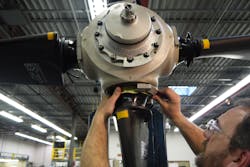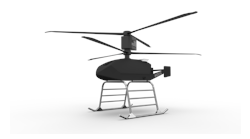Turboprop Market: Growth Drives Greater Need for Best Practices
For commercial aircraft maintenance repair and overhaul organizations (MROs), growth opportunities are apparent, especially within the Asia-Pacific and Latin America (Central and South America) markets. According to the “Commercial Aircraft Maintenance, Repair & Overhaul (MRO) Market Forecast 2015-2025” presented by the business intelligence provider, visiongain (London, UK), the air transport MRO market for jets and turboprops combined is expected to grow to $86.8 billion by 2024; up from $57.7 billion in 2014.
The highest growth opportunities for commercial aircraft MROs are expected to come from emerging markets experiencing broad expansion of their air transport infrastructure. While clearly this is good news for MRO organizations, there are also challenges to be faced as MROs seek to match their capabilities and commercial offerings to changing customer requirements. To optimize relationships, it’s important for airlines to understand both market dynamics and how MROs in key component sectors, such as propellers maintenance, are responding to meet their needs.
State of Regional MRO Turboprop Market
In its “Regional Turboprop Market Outlook, 2014-2033,” ATR, a joint venture of Alenia Aermacchi SpA (Venegono Superiore, Italy) and Airbus Group (Toulouse, France), forecasted that airlines will require 3,400 new turboprops with deliveries averaging around 140 aircraft per year between 2014 and 2023 and 190 aircraft per year between 2024 and 2033 at a value of approximately $80 billion. For services organizations, these fleet increases cut both ways. Some airlines with substantial orders and an already large fleet are considering the expansion of their in-house MRO capabilities. Also posing a potential challenge to MROs are next-generation aircraft for which longer intervals between service and less maintenance may be required.
For proactive MROs, staying ahead of these challenges and capitalizing on the many growth opportunities means adapting their processes and harnessing leading-edge technologies so that they can continue to offer airlines a strong value proposition. At APS, for example, it recently implemented a brush-plating repair solution for damaged, Cad-plated steel torque plates on propeller hubs. APS secured the OEMs, and as a result it now has a repair which not only saves parts from being scrapped, thereby extending their lifespan, but also represents an effective solution for damaged Cad-plated steel plates that can be repaired at one-third the previous costs.
Propeller maintenance offers some unique challenges given the critical to flight nature of the assembly and subassemblies, as well as the combination of metal and composite materials that experience dramatic loads and environmental conditions in flight. If maintained properly, the key driver of component removals is mandated time between overhauls (TBO). Unscheduled work is generally limited to on-engine damage through FOD and, frankly speaking, a lack of attention to detail with respect to painting, cleaning, and replacement of consumables which protect expensive parts like the deicer element on the blades. Well-maintained props can stay on engine for more than five years and, in some cases, 10,000 flight hours. At that point, they come off for their scheduled, time-between-overhaul maintenance.
Apart from the maintenance and repair processes MRO service providers are applying, there is also the emphasis on preventive maintenance measures by line maintenance crews and material handlers. Customer-oriented MROs are adamant regarding educating their clients about best in class processes to prevent damage. Given that corrosion is one of the major culprits, corrosion prevention is stressed.
Preventing Corrosion on Propellers
For an airline, this message from a propeller MRO service provider can’t be good. “Our technicians found corrosion on your blade shank. We will be processing the repair order as a scrap. The new replacement blade is $70,000 and has a 180-day lead time. Please advise.” If the part is relatively new, the news is even worse. The facts are, however, corrosion is one of the leading causes for scrapping costly propeller components. What makes it harder to take is that corrosion can be prevented with best practices designed to ensure that components remain useful through their second, third, and fourth overhaul cycles. While MRO organizations provide services designed to promote high-quality propeller performance and optimal lifespan, there are important preventive steps that operators should implement for both assembled propellers not in regular use, as well as, for propeller components in storage or being prepared for shipment. Figure I presents a checklist of measures designed to prevent corrosion and early scraps, while also limiting work scopes when blades are sent to the MRO for repairs.
Maintaining Composite Components
One area, in particular, where MROs are proving essential to the optimum maintenance of turboprop aircraft is for advanced manufactured composite components. Composite aircraft components have been steadily increasing for the past several years. For MROs, understanding the properties of composites and developing best in class processes for the maintenance and repair of composite components is critical to their success.
Given the cost of fuel – one of the airlines’ major expenses – and the significant role of composites in reducing fuel costs, it’s easy to understand the growing use of composites by aircraft manufacturers. In addition to the cost savings associated with the lower weight’s impact on fuel consumption, composites offer other benefits. Because of their lower weight, composite propellers require less horsepower than metal propellers to generate an equivalent thrust.
Composite blades also provide properties of higher strength, non-shrinking after repairs (i.e., the ability to retain their original dimensions), and corrosion resistance. That is not to say, however, that composite components are not subject to stresses. Ultraviolet (UV) light will affect the strength of composite materials and lightning strikes can damage composite propellers. In addition, blades composed of composite materials such as fiberglass (also used for aircraft fairings, radomes, and wing tips) and Kevlar (Dupont’s aramid fiber product used in various aircraft components, body, exterior, and interior surfaces) contain other materials, specifically aluminum mesh for lightning protection, which is subject to corrosion around certain parts (e.g., bolts, screw holes, etc.).
Therefore, if not maintained properly, composite components can also be subject to corrosion. Various inspections are undertaken to detect damage caused by lightning, stone, hail, or small bird strikes; corrosion; excessive heat; and/or erosion of protective coatings/paints; cracks in the hub or bolts; alignment problems, etc. The repairs on composite blades include some of the measures used for metal blades, as well as others presented in a composite blade workscope. These include: sanding down nicks in a manner that does not remove too much material, painting the blades with the appropriate coating which may include a layer of paint designed to address static caused by precipitation, and taking precautionary measures when addressing damage to a blade’s leading edge, which on composite blades incorporates a bonded erosion shield that must be removed through a debonding process, and a new shield rebonded to the blade.
As composite technology continues to evolve, and design specifications become more strict, aircraft operators and repair organizations' attention to detail must get tighter as well. The entire product sustainment chain must keep pace with precise measurement and processing equipment. These developments put an even greater demand on organizations to recruit, train, and retain a highly skilled workforce.
Future Innovations
MROs like APS are exploring ways to improve the total cost of ownership associated with propeller assemblies. In general, techniques being explored align with three strategies: 1. Ensure the components make it to their TBOs, 2. Reduce the costs of overhaul at the TBO and, 3. Increase the number of overhauls experienced before scrap. Some of the techniques and procedures being explored are: early removal of actuators to reduce the chances of some of the major piece parts scrapping at overhaul, replacement of hub oil more often than current recommendations to reduce wear and tear as well as corrosion, and exploration of additional repairs to metal interfaces when corrosion and other damage does indeed set in.
Dennis Santare is vice president, sales and marketing for Aircraft Propeller Service LLC (APS), in Lake Zurich, IL, a propeller maintenance repair organization (MRO). For more information visit www.aircraftpropeller.com.


